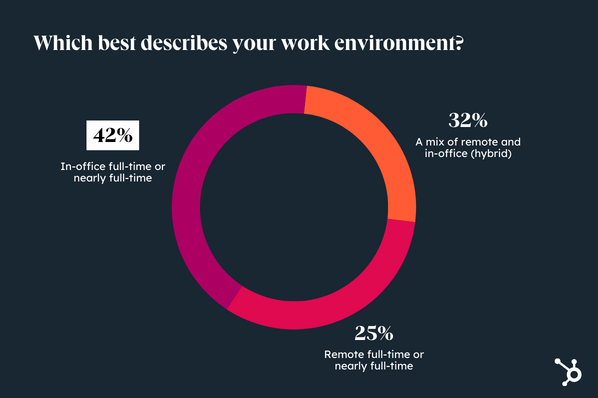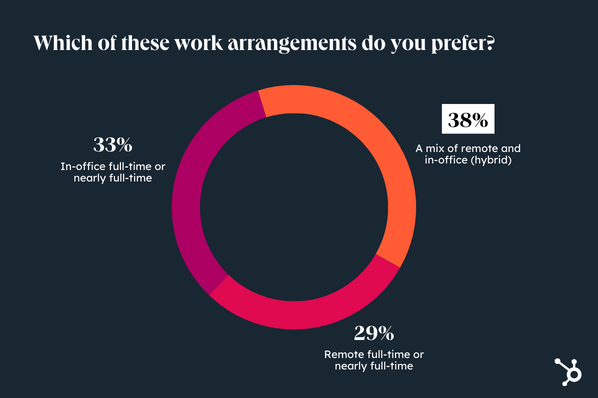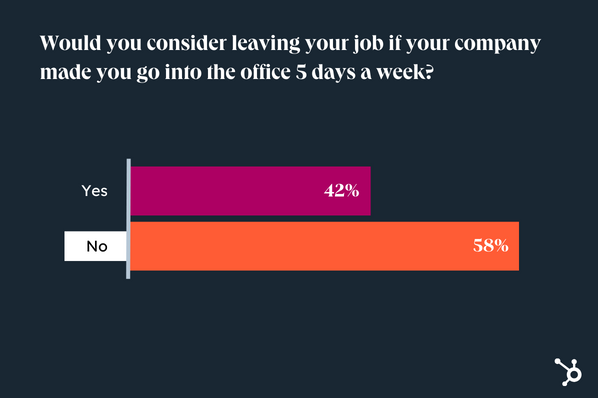I saw a pretty compelling statistic recently: Before the pandemic, just 8% of companies offered flexible work policies. After the fact, nearly two thirds (62%) have implemented some level of flex work.

Fast forward to today, and many companies (like Tesla and Goldman Sachs) have asked workers to return to office full-time.
I always assumed the WFH trend wouldn’t last forever. But the benefits of remote work for both employees and employers are hard to ignore.
So, how is everyone feeling about return to office mandates in 2024?
Table of Contents
- Are workers willing to return to office?
- Why are companies bringing employees back?
- The Impact of Return to Office Mandates
- How to Implement a Return to Office Mandate (If Necessary)
Are workers willing to return to office?
According to our survey of 700+ consumers, 42% have already returned to office full-time or nearly full-time.

But the question is: Are employees willing to return to office? While it’s not a hard no, 38% of employees still prefer a hybrid work model.

Regardless, the majority (58%) would not consider leaving their current job if their company made them go into the office five days a week.

And lack of remote work options isn’t one of the top reasons employees are considering leaving their current job. Our findings suggest that pay is the biggest motive.

Why are companies bringing employees back?
Every company has its own reasons for asking employees to return to the office. Here are a few of the big ones.
Availability of Office Space
While many companies ditched their office space in response to the pandemic, some held on. This is one reason businesses are calling for a return to office — they have a physical workspace to support it.
According to a recent survey, 51% of companies that have an office space currently require some or all employees to work in-person. And 39% plan to by the end of 2024.
More Opportunities for Collaboration
The number one pain point for companies in the remote work era is disconnected systems. That’s why many employers believe the in-office work environment creates connection.
And they’re not all wrong. We found that 40% of remote workers reportedly miss spontaneous, in-person connections with their colleagues.
Increased Productivity
‘Productivity paranoia’ represents the idea that lost productivity is a direct result of employees not working.
And remote work has only magnified the skepticism, regardless of the fact that 62% of workers feel more productive at home.
Still, 37% of employers have added or increased the use of employee tracking software. And many believe return to office mandates will equate to greater productivity at work.
HubSpot uses the information you provide to us to contact you about our relevant content, products, and services. HubSpot will share the information you provide to us with the following partners, who will use your information for similar purposes: Glimpse. You can unsubscribe from communications from HubSpot at any time. For more information, check out HubSpot's Privacy Policy. To unsubscribe from Glimpse's communications, see Glimpse's Privacy Policy.

U.S. Consumer Trends Report
Learn how consumers act, how they think, and what they expect now and beyond. Topics include:
-
Purchase habits.
-
Data privacy.
-
Workplace trends.
-
And more!
The Impact of Return to Office Mandates
Among companies who have returned to office, the majority say they’ve seen some level of improvement in revenue, productivity, and worker retention.
At the individual level, I’d say the mandates affect everyone differently.
Some people do actually feel more productive in the office.
I also think it depends on the job. There’s a lot of discourse on social media about the purpose of return to office mandates.
Like this TikTok about going into the office just to sit in Zoom meetings all day.
@1corporatemillennial i love it here 🥲 #corporatemillennial #millennialsoftiktok #corporate #corporatehumor #corporateamerica #corporatejob #corporatejokes #corporatelife #corporatetok #corporatetiktok #work #workhumor #workjokes #worklife #workmemes #worksatire #office #officejokes #officelife #officehumor #job #jobhumor #jobsatire #9to5 #wfh #wfhjokes #wfhlife #workfromhome ♬ I been drinking - Ma
Based on the conversations I’ve seen on the topic, employees are responding to these mandates based on two main factors.
Trust
Many companies adjusted their policies to accommodate flexible work, and now those policies are quickly changing.
The employee perspective: If I accepted a job with the expectations of working remotely, shouldn’t my company honor that?
Practicality
Asking employees to return to the office requires additional time (and money) to commute. And many employees feel more productive at home.
The employee perspective: If I can do my job effectively from home (which the pandemic has proven), why should I go back in?
How to Implement a Return to Office Mandate (If Necessary)
If you’re an employer thinking of requiring a full-time return to the office, here are some tips to consider.
1. Explain the mandate with transparency.
Many employees have become comfortable working from home. They feel more productive, have greater flexibility, and can effectively complete their assigned duties.
That’s why transparency is key when you’re asking them to switch up their routine.
First, communicate the goals behind your return to office mandate. Then, clearly explain the benefits to your employees and how you plan to support them during the transition.
You still may get some push-back, but at least you’ll have some concrete rationale to lean on.
2. Use empathy and patience throughout the transition.
Everyone’s circumstances are different. As you think through your company’s transition back to office, make sure to proceed with care.
Rather than implementing one overarching policy, consider setting guidelines based on the needs of your individual employees and teams.
For example, our recent State of Sales report showed that salespeople perceive selling remotely as less effective than in-person sales. In this case, returning to the office may be viewed as a benefit for your sales team.
But that doesn’t mean the same is true for your other functions, like marketing or customer service.
3. Encourage a healthy work-life balance.
One of the top reasons that employees change jobs is for a better work-life balance. To help your employees transition back to the office, consider offering alternatives like:
- Flexible office and home hours on light meeting weeks
- A company-wide meeting free day each week (Our HubSpotters love our Meeting-Free Fridays!)
- A few more vacation days in summer or during the winter holidays
- Extra time off for work anniversaries. (An example of this would be HubSpot's 5-Year Sabbatical Program)
- Additional family, sickness, or mental health leave options when possible
4. Consider a hybrid work model.
As discussed earlier, the majority of employees still prefer a hybrid work model. If remote or hybrid work is doable for your business, build a strategy to support it.
If a hybrid model isn’t feasible, then you can always implement some of the strategies I’ve outlined in Step 3. Just remember that some of your talent may move elsewhere if they prefer the flexibility.
Navigating RTO
Before asking employees to return to the office, make sure you truly understand why you want employees to come back. Plan ahead, lead with transparency, and give your employees the tools to make a smooth transition.
![Download Now: The State of U.S. Consumer Trends [Free Report]](https://no-cache.hubspot.com/cta/default/53/ebf9ec8e-a468-455a-943e-80aa4e6be694.png)










